26 books about Microwaves

Corrugated Horns for Microwave Antennas
P.J.B. Clarricoats
The Institution of Engineering and Technology, 1984
Over the last twenty years Corrugated horns have become widely used as feeds for microwave reflector antennas because of their high efficiency, good pattern symmetry and low cross-polarisation. They are increasingly used in antennas for satellite communications, radar, microwave point to point communications and radio astronomy.
[more]

Electromagnetic Waveguides
Theory and applications
S.F. Mahmoud
The Institution of Engineering and Technology, 1991
There are several ways to classify electromagnetic waveguides. Depending on their boundaries, they can be classified into waveguides with perfectly reflecting walls or finite impedance walls, as well as open waveguides. In terms of their applications, there are the low attenuation and low delay distortion waveguides for telecommunication, the low crosspolar field waveguides used as feeds for reflector antennas in frequency reuse schemes, as well as the leaky feeders in continuous access communication systems. There are also the natural waveguides such as tunnels and the earth-ionosphere waveguide.
[more]

Engineers' Handbook of Industrial Microwave Heating
Roger Meredith
The Institution of Engineering and Technology, 1998
Heating materials using microwave energy offers many advantages in industrial processes, including improved quality, efficiency and control. There is a growing interest in microwave heating throughout industry and there are now many research establishments, both academic and industrial, working in this field. Microwave technology is a well developed science in the areas of radar and communications, supported by a large bibliography, but this is not the case for its applications to industry. The aim of this book is first to present the fundamentals of microwave technology that are relevant to industrial practice in a manner accessible to engineers, scientists and technicians who may have little or no prior knowledge of the subject. Second, it presents a perspective on the range and scope of the techniques and hardware used, giving detailed descriptions, making critical comparisons and commenting frequently on practical issues of design.
[more]

Ferrites at Microwave Frequencies
A.J. Baden Fuller
The Institution of Engineering and Technology, 1987
Between 1950 and 1965, there was a spate of intense activity to investigate the theory and application of ferrite materials at microwave frequencies, and in the early 1960s a number of textbooks on the microwave applications of ferrites were published, but nothing comprehensive since. Now this book has been written to consolidate all the investigations of ferrites for microwave applications, to look back at earlier publications from the viewpoint of a mature technology, and to bring the story up to date. This book attempts to give all the structures and applications using ferrites at microwave frequencies that havebeen investigated or contemplated, using the engineer's rather than the physicist's approach. It starts with a full mathematical treatment of the interaction of an electromagnetic wave with a gyromagnetic ferrite material for simple boundary conditions. These results are then extended to give a field descriptive approach to describe the mode of operation of all the different microwave devices.
[more]
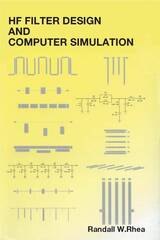
HF Filter Design and Computer Simulation
Randall W. Rhea
The Institution of Engineering and Technology, 1994
A book for engineers who design and build filters of all types, including lumped element, coaxial, helical, dielectric resonator, stripline and microstrip types. A thorough review of classic and modern filter design techniques, containing extensive practical design information of passband characteristics, topologies and transformations, component effects and matching. An excellent text for the design and construction of microstrip filters.
[more]

Microwave Antenna Theory and Design
Samuel Silver
The Institution of Engineering and Technology, 1984
Microwave Antenna Theory and Design is an unabridged reprint of the book published by McGraw Hill, as Volume 12 of the MIT Radiation Laboratory Series in 1949. The Editor of the Volume, the late Professor Samuel Silver, contributed extensively to the text and subsequently became one of the best known people in the world of radio science.
[more]

Microwave Circuit Theory and Foundations of Microwave Metrology
Glenn F. Engen
The Institution of Engineering and Technology, 1992
No system in science or engineering can be successfully designed, analysed and specified unless it is backed up by precise quantitative measurements. This is particularly difficult in the field of microwaves where, more often than not, the parameter(s) of interest cannot be observed directly but must be inferred from the measurement of other related parameters. Although the advent of the automated network analyser has eliminated much of the previous drudgery, the problems of interpreting the digitally displayed information still remain. One purpose of this book is to provide the reader with a thorough understanding of the microwave circuit model and its limitations, and thus eliminate the many potential pitfalls that otherwise await the unwary experimenter.
[more]

Microwave Horns and Feeds
A.D. Olver
The Institution of Engineering and Technology, 1994
This book is the first comprehensive treatment of microwave horns and feeds for reflector antennas for use in satellite and terrestrial communications, radar and radio astronomy. The feed for a reflector antenna is a crucial component because the performance of the reflector depends on a good feed to collect or radiate signals.
[more]
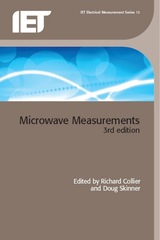
Microwave Measurements
R.J. Collier
The Institution of Engineering and Technology, 2007
The IET has organised training courses on microwave measurements since 1983, at which experts have lectured on modern developments. The purpose of this third edition of the lecture notes is to bring the latest techniques in microwave measurements to a wider audience. The book includes a survey of the theory of current microwave circuits as well as a description of the techniques for the measurement of power, spectrum, attenaution, circuit parameters, and noise, measurements of antenna characteristics, free fields, modulation and dielectric parameters. The emphasis throughout is on good measurement practice. All the essential theory is given and a previous knowledge of the subject is not assumed. The book will be of interest to those engaged in the design of microwave measurement systems in both research and industry, those providing microwave measurement systems in both research and industry, in measurement services and those involved in teaching microwave measurements in universities.
[more]
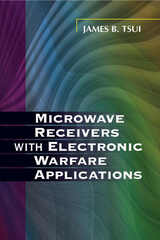
Microwave Receivers with Electronic Warfare Applications
James Bao-Yen Tsui
The Institution of Engineering and Technology, 2005
This book is a treatise on EW receivers that is relevant to you if you are just looking for a top-level insight into EW receivers or need to know the intricate details of cause and effect behavior in EW receiver theory and design. The book begins with a general discussion of EW receivers in their functional context and then goes into just the right amount of detail about the theoretical characteristics common to all receiver designs. Examples of this include receiver design issues impacting probability of detection, false alarm rate, and dynamic range performance. Tsui then describes the important characteristics of key emitter parameters to be measured by an EW receiver. He goes on to systematically cover each of the types of EW receivers by dedicating a chapter to each in well-organized and exquisite detail.
[more]

Open Electromagnetic Waveguides
T. Rozzi
The Institution of Engineering and Technology, 1997
Electromagnetic waves are guided by open structures in a variety of applications at radio, microwave, millimetric and optical frequencies. Examples range from the propogation of radiowaves down the shaft of an oil rig to that of light through an optical fibre. As the guide is open, radiation may also be present, for example from a microstrip-fed patch or a slot antenna. These twin aspects of waveguiding and radiation are in fact closely interwoven and this book is the first to deal with the two by means of a single mathematical formalism.
[more]
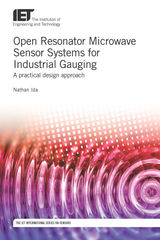
Open Resonator Microwave Sensor Systems for Industrial Gauging
A practical design approach
Nathan Ida
The Institution of Engineering and Technology, 2018
Open resonator microwave sensors allow accurate sensing, monitoring and measurement of properties such as dimension and moisture content in materials including dielectrics, rubber, polymers, paper, fabrics and wood veneers. This book presents a coherent and entirely practical approach to the design and use of systems based on these sensors in industrial environments, showing how they can provide meaningful, accurate and industrially-viable methods of gauging.
[more]

Principles of Microwave Circuits
C.G. Montgomery
The Institution of Engineering and Technology, 1987
Principles of Microwave Circuits is an unabridged reprint of the book first published in 1948 by McGraw Hill as Volume 8 of the MIT Radiation Laboratory Series. Since the original publication of this book, a number of errors have been brought to our attention. Corrections of these errors are incorporated in this edition.
[more]

Principles of Microwave Measurements
G.H. Bryant
The Institution of Engineering and Technology, 1993
With this book engineers will understand the fundamental theoretical bases of modern microwave measurements. The narrative is firmly based on the principles of swept frequency techniques, though single frequency measurements, for instance of power, are also fully covered. By the use of flowgraph techniques and careful approximations, the author has given physical meaning to the mathematical arguments and has been careful to show the practical and theoretical limitations on measurement accuracy. The book covers a wide range of microwave measurements in the time and frequency domains, including reflectometry, the Smith chart, spectrum analysers, vector and scalar analysers, multiports, power, noise, frequency stability, time domain reflectometry, and a comprehensive account of antenna far and near field measurements. It is particularly recommended for young engineers requiring a good background in microwave measurement principles and will also be a useful reference for more experienced engineers.
[more]

Propagation, Scattering and Diffraction of Electromagnetic Waves
A.S. Ilyinski
The Institution of Engineering and Technology, 1993
This book describes new, highly effective, rigorous analysis methods for electromagnetic wave problems. Examples of their application to the mathematical modelling of micros trip lines, corrugated flexible waveguides, horn antennas, complex-shaped cavity resonators and periodic structures are considered.
[more]
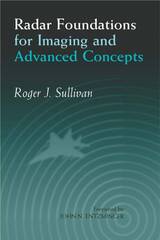
Radar Foundations for Imaging and Advanced Concepts
Roger J. Sullivan
The Institution of Engineering and Technology, 2004
Through courses taught internally at the Institute for Defense Analysis, Dr. Roger Sullivan has devised a book that brings readers fully up to speed on the most essential quantitative aspects of general radar in order to introduce study of the most exciting and relevant applications to radar imaging and advanced concepts: Synthetic Aperture Radar (4 chapters), Space-time Adaptive Processing, moving target indication (MTI), bistatic radar, low probability of intercept (LPI) radar, weather radar, and ground-penetrating radar. Whether you are a radar novice or experienced professional, this is an essential reference that features the theory and practical application of formulas you use in radar design every day. With this book, you are taken step-by-step through the development of modern airborne microwave radar, up to the cutting edge of emergent technologies including new results on theoretical 2D and 3D SAR point-spread functions (PSF) and current discussions concerning dechirp/deskew processing, layover in SAR images, vibrating targets, foliage penetration, image quality parameters, and more. Plus, for students of electrical engineering, physics, and radar, this book provides the best source of basic airborne radar understanding, as well as a broad introduction to the field of radar imaging.
[more]
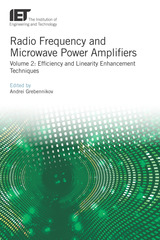
Radio Frequency and Microwave Power Amplifiers
Efficiency and Linearity Enhancement Techniques, Volume 2
Andrei Grebennikov
The Institution of Engineering and Technology, 2019
Radio Frequency and Microwave Power Amplifiers are finding an increasingly broad range of applications, particularly in communications and broadcasting, but also in the industrial, medical, automotive, aviation, military, and sensing fields. Each application has its own design specifications, for example, high linearity in modern communication systems or high efficiency in broadcasting, and, depending on process technology, capability to operate efficiently at very high frequencies, such as 77 GHz and higher for automotive radars. Advances in design methodologies have practical applications in improving gain, power output, bandwidth, power efficiency, linearity, input and output impedance matching, and heat dissipation.
[more]
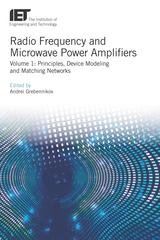
Radio Frequency and Microwave Power Amplifiers
Principles, Device Modeling and Matching Networks, Volume 1
Andrei Grebennikov
The Institution of Engineering and Technology, 2019
Radio Frequency and Microwave Power Amplifiers are finding an increasingly broad range of applications, particularly in communications and broadcasting, but also in the industrial, medical, automotive, aviation, military, and sensing fields. Each application has its own design specifications, for example, high linearity in modern communication systems or high efficiency in broadcasting, and, depending on process technology, capability to operate efficiently at very high frequencies, such as 77 GHz and higher for automotive radars. Advances in design methodologies have practical applications in improving gain, power output, bandwidth, power efficiency, linearity, input and output impedance matching, and heat dissipation.
[more]

Radio Frequency and Microwave Power Measurement
Alan E. Fantom
The Institution of Engineering and Technology, 1990
The need to measure electrical power is common to many branches of science and engineering. This book presents a wide-ranging survey of the many types of radio-frequency and microwave power meter and the techniques which are used for calibrating and intercomparing them. The frequency range is 1 MHz to 200 GHz.
[more]

Retro-reflective Beamforming Technique for Microwave Power Transmission
Mingyu Lu
The Institution of Engineering and Technology, 2024
Microwave power transmission technology, which is a sub-discipline of the wireless power transmission technology, aims to transmit electrical power without using wires/cables in the microwave frequency band. The retro-reflective beamforming technique has the potential to enable efficient and safe microwave power transmission, as it includes the following two technical elements. First, a directional microwave beam is generated as the carrier of wireless power. Second, the microwave power beam could be steered in real time toward mobile wireless power receiver(s). This book offers a comprehensive narrative of retro-reflective beamforming in the context of microwave power transmission.
[more]
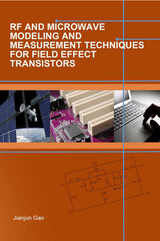
RF and Microwave Modeling and Measurement Techniques for Field Effect Transistors
Jianjun Gao
The Institution of Engineering and Technology, 2010
This book is an introduction to microwave and RF signal modeling and measurement techniques for field effect transistors. It assumes only a basic course in electronic circuits and prerequisite knowledge for readers to apply the techniques and improve the performance of integrated circuits, reduce design cycles and increase their chance at first time success. The first chapters offer a general overview and discussion of microwave signal and noise matrices, and microwave measurement techniques. The following chapters address modeling techniques for field effect transistors and cover models such as: small signal, large signal, noise, and the artificial neural network based.
[more]
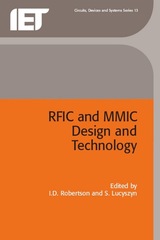
RFIC and MMIC Design and Technology
I.D. Robertson
The Institution of Engineering and Technology, 2001
RFIC and MMIC technology provides the core components for many microwave and millimetre-wave communications, radar and sensing systems. Recent years have seen exciting developments, such as circuits operating to over 200 GHz, millimetre-wave micromachined antenna arrays and microelectromechanical systems (MEMS). At the same time, the rapid growth of wireless communications in the 1 to 6 GHz range has seen a dramatic shift towards advanced silicon technology. It is timely, therefore, to introduce this fully up-to-date second edition of a world-renowned standard text.
[more]
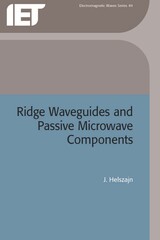
Ridge Waveguides and Passive Microwave Components
J. Helszajn
The Institution of Engineering and Technology, 2000
The ridge waveguide, which is a rectangular waveguide with one or more metal inserts (ridges), is an important transmission line in microwave engineering, through which many passive components can be achieved. As such it is a well-established and widely used element in commercial electronics and communications devices. This book collects together much of the work of Professor Helszajn, an international authoriy in the field, and will enable the reader to have direct access to this material without need for exhaustive search of research papers. Generously illustrated, it is likely to become the definitive reference source on this topic. The book includes closed-form and finite element calculations of the propagation constant, attenuation and mode spectrum for the ridge waveguide, as well as power-current and power-voltage definitions of impedance. Circular polarisation is also treated. Propagation properties where the waveguide has a dielectric filler are calculated. The treatment is then extended to more complex designs, including quadruple ridge waveguides with and without a gyromagnetic filler. The text includes descriptions of many of the passive devices which can be realised using these waveguides, including isolators, phase shifters and circulators. A treatment of the finline waveguide is included as its geometry is closely related to that of the ridge waveguide, leading to components such as the 3-port finline calculator.
[more]
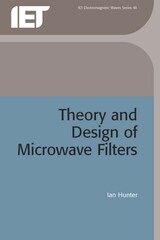
Theory and Design of Microwave Filters
Ian Hunter
The Institution of Engineering and Technology, 2001
Microwave filters are vital components in a huge variety of electronic systems, including the rapidly growing communications industry behind mobile radio and satellite communications, as well as radar and other microwave technologies. Ian Hunter provides a graduate-level text that has the aim of enabling the engineer to understand the theory and design of microwave filters.
[more]

Theory of Nonuniform Waveguides
The cross-section method
B.Z. Katsenelenbaum
The Institution of Engineering and Technology, 1998
The cross-section method is an analytical tool used in the design of components required for low-loss, highly efficient transmission of electromagnetic waves in nonuniform waveguides. When the waveguide dimensions are large compared with the wavelength, a fully three-dimensional analysis employing modern numerical methods based on finite element, finite difference, finite integration or transmission line matrix formalisms is practically impossible and the cross-section method is the only feasible analysis technique.
[more]
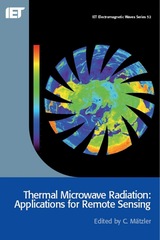
Thermal Microwave Radiation
Applications for remote sensing
C. Mätzler
The Institution of Engineering and Technology, 2006
This book combines theoretical concepts with experimental results on thermal microwave radiation to advance the understanding of the complex nature of terrestrial media. With the emphasis on radiative transfer models the book covers the most urgent needs for the transition from the experimental phase of microwave remote sensing to operational applications. All terrestrial aspects are covered from the clear to the cloudy atmosphere, precipitation, ocean and land surfaces, vegetation, snow and ice.
[more]
READERS
Browse our collection.
PUBLISHERS
See BiblioVault's publisher services.
STUDENT SERVICES
Files for college accessibility offices.
UChicago Accessibility Resources
home | accessibility | search | about | contact us
BiblioVault ® 2001 - 2024
The University of Chicago Press









